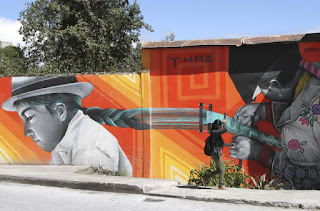06DEC2018 - 'The ancient leather tanners of Ecuador- "In the town of Cotacachi, Ecuador, which bustles with more than 50 leather artisans and shops, one family still holds on to a centuries-old tanning recipe.
A strong smell of salt, leather and wet fur permeated the tiny workshop where Luis Yamberla Cacuango was busy working on an intricate leather belt pattern.Out in the spacious back yard, cowhides, llama pelts and goat skins were in various stages of processing. Stacked and covered in salt, steeping in lime or tanning in a large barrel, the skins and hides were being worked on with simple tools: a smooth stone to scrape the remaining meat from a raw hide; stone and wood barrels to hold and process the skins.
As Yamberla and his father, Luis Sr, busied themselves in the workshop, Yamberla’s mother Maria Virginia offered me some of her homemade chicha, a drink made of fermented corn and wheat, then carried on brushing a sheepskin and chatting to her granddaughters and nieces in her native Quichua.
Cotacachi, a small, quiet mountain town in Ecuador’s Imbabura Province, is famous for its leather artisans who offer various items around the plaza de armas (main square) and in the surrounding streets, kiosks, stalls and shops. Beautifully decorated saddles and bridles, jackets, bags and purses, souvenirs and shoes – in Cotacachi, leather is everywhere.
This town has been making leather products for hundreds of years, largely because of the surrounding cattle and dairy farms that used to be a primary source of raw hides. “Now, most of the leather, already processed, arrives from the nearby town of Ambato or as far as Colombia to save costs,” Yamberla told me...." -



No comments:
Post a Comment